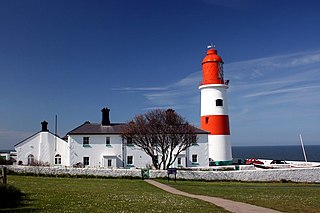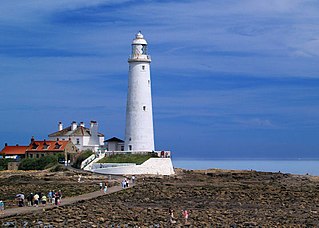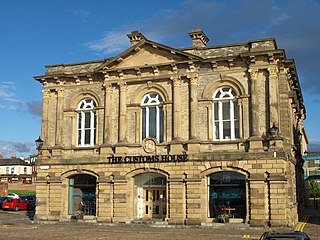
Gateshead is a town in the Gateshead Metropolitan Borough of Tyne and Wear, England. It is on the River Tyne's southern bank. The town's attractions include the twenty metre tall Angel of the North sculpture on the town's southern outskirts, The Glasshouse International Centre for Music and the Baltic Centre for Contemporary Art. The town shares the Millennium Bridge, Tyne Bridge and multiple other bridges with Newcastle upon Tyne.

South Tyneside is a metropolitan borough in the metropolitan county of Tyne and Wear, England. It is bordered by all four other boroughs in Tyne and Wear: Gateshead to the west, Sunderland in the south, North Tyneside to the north and Newcastle upon Tyne to the north-west. The border county of Northumberland lies further north. The borough was formed on 1 April 1974 by the merger of the County Borough of South Shields with the municipal borough of Jarrow and the urban districts of Boldon and Hebburn from County Durham.

North Tyneside is a metropolitan borough in the metropolitan county of Tyne and Wear, England. It forms part of the greater Tyneside conurbation. North Tyneside Council is headquartered at Cobalt Park, Wallsend.

South Shields is a coastal town in South Tyneside, Tyne and Wear, England; it is on the south bank of the mouth of the River Tyne. The town was once known in Roman times as Arbeia and as Caer Urfa by the Early Middle Ages. In 2021 it had a population of 75,337. It is the fourth largest settlement in Tyne and Wear, after Newcastle upon Tyne, Sunderland and Gateshead.

Tyneside is a built-up area across the banks of the River Tyne in Northern England. Residents of the area are commonly referred to as Geordies. The whole area is surrounded by the North East Green Belt.

North Shields is a town in the borough of North Tyneside in Tyne and Wear, England. It is 8 miles (13 km) north-east of Newcastle upon Tyne and borders nearby Wallsend and Tynemouth.

The history of Newcastle upon Tyne dates back almost 2,000 years, during which it has been controlled by the Romans, the Angles and the Norsemen amongst others. Newcastle upon Tyne was originally known by its Roman name Pons Aelius. The name "Newcastle" has been used since the Norman Conquest of England. Due to its prime location on the River Tyne, the town developed greatly during the Middle Ages and it was to play a major role in the Industrial Revolution, being granted city status in 1882. Today, the city is a major retail, commercial and cultural centre.

Tyne Dock is a neighbourhood within the town of South Shields, Tyne and Wear, on the south bank of the River Tyne. It takes its name from the large dock on the river which was opened in 1859 by the North Eastern Railway to handle Tyneside's coal exports. At its height the trade amounted to seven million tons of coal transported via the four staiths which had been built to facilitate the process. This trade declined in the second half of the twentieth century and the bridges that carried the coal trains into the dock, the famous Tyne Dock Arches, were demolished from 1977 on. The dock itself has been progressively infilled since closure, allowing for the building of modern storage warehouses. This process concluded with the final 13 acres that were filled in as part of the project to build the second Tyne Tunnel. The Tyne Dock basin was filled with 400,000 cubic metres of sediment dredged from the Tyne.

Sir Edward Blackett, 2nd Baronet was an English landowner and politician who sat in the House of Commons at various times between 1689 and 1701.
Sir William Blackett, 1st Baronet was a businessman who founded a mercantile and industrial base in Newcastle and a politician who sat in the House of Commons from 1673 to 1680.
The Keelmen of Tyne and Wear were a group of men who worked on the keels, large boats that carried the coal from the banks of both rivers to the waiting collier ships. Because of the shallowness of both rivers, it was difficult for ships of any significant draught to move up river and load with coal from the place where the coal reached the riverside. Thus the need for shallow-draught keels to transport the coal to the waiting ships. The keelmen formed a close-knit and colourful community on both rivers until their eventual demise late in the nineteenth century.

The Customs House is an arts and entertainment venue in the Mill Dam Conservation Area of South Shields, South Tyneside. It opened in July 1864 as a custom house, built to facilitate the import and export of goods at Shields Harbour. Before 1865, both North Shields and South Shields operated as a single customs port following their separation from the Newcastle Customs House in 1848. South Shields was granted customs independence from North Shields in 1865, in part due to the construction of the new custom house building in the town. An extension was added to the building in 1878 to house the Marine Board offices. In the 1970s, the decline of the local shipping industry meant the custom house became derelict. In 1992, the Tyne and Wear Development Corporation led a restoration effort and extension of the building, transforming it into an arts centre.
Captain Sir Thomas Liddell, 1st Baronet (1578–1652) was an English politician, a member of the Liddell family which monopolized the local government of the North of England during the 16th and 17th centuries. He was one of the leading supporters of the Royalist cause in the English Civil War.
The Port of Tyne comprises the commercial docks on and around the River Tyne in Tyne and Wear in the northeast of England.

North Shields Pottery was an English pottery manufacturer that created earthenware ceramics from circa 1814 to circa 1913 under a succession of owners and company names.
William Carr II, FRS of Newcastle-upon-Tyne was an English Whig politician who sat in the House of Commons between 1722 and 1734.
Colonel George Liddell (1678–1740), of Eslington Park, Northumberland, was a British coal owner and Whig politician who sat in the House of Commons from 1727 to 1740. He was one of the dominant figures in the coal-business in the North East, and was a colonel in the militia who was active against the Jacobite threat.

The office of Sheriff of Newcastle upon Tyne existed from 1400 until local government reorganisation in 1974, and was reintroduced in 1996 as a title held additionally by the Deputy Lord Mayor of Newcastle upon Tyne. The city has a sheriff because it was historically a county corporate.

The Grand Allies, or Grand Alliance, was a cartel of English coal-owning families formed in 1726. It was based on the Northumberland and Durham Coalfield, and played a major role in the economics of mining coal from the field for about a century. Over time, other families joined the original main three.













